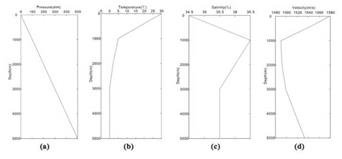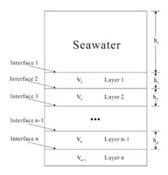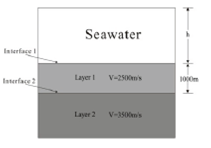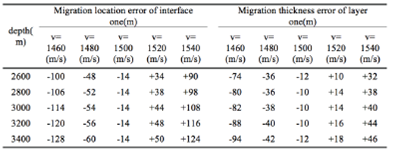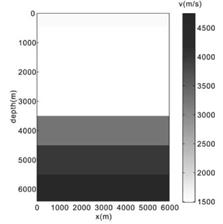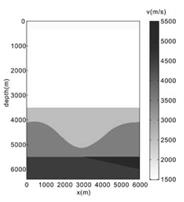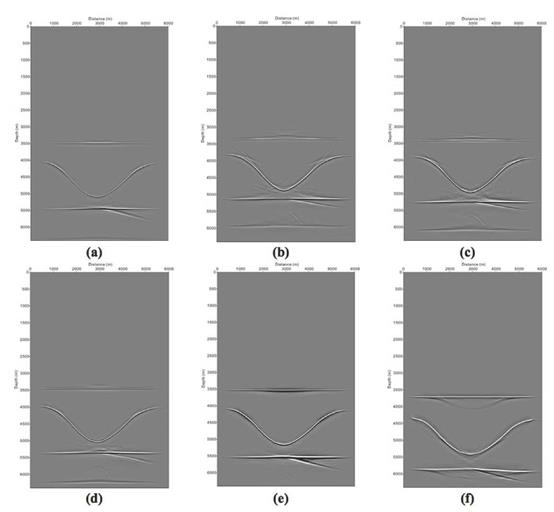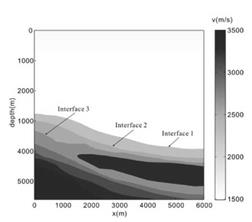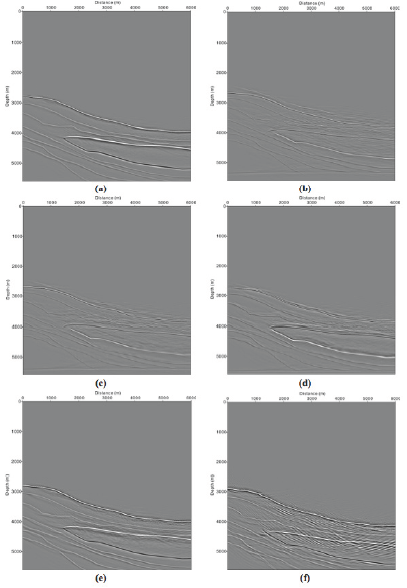Introduction
As more and more offshore oil and gas fields have been discovered recently, the exploration difficulty for new ones increases sharply. Thus, growing number of human and financial resources has been invested into deep-sea oil and gas exploration worldwide (Barely, 1999). The South China Sea is rich in oil resource while 70% of that located in the deep sea (Li, 2006). During latest ten years the South China Sea oil and gas exploration experienced both more and more attention from the government and also a series of problems of which one exists in migration processing on marine seismic data. The problem can be described as the movement energy not high enough in deep water so that the real structure and stratum could not be recognized clearly and exactly. The paper aims at solving it, thus analyzes the affection of variable seawater-velocity on migration in deep water from the perspective of velocity model's accuracy.
Physical oceanography study reveals that the main influencing factors on the acoustic velocity of seawater are temperature, pressure, and salinity (Feng, 1999; Jones, 1999) which are also correlated with depth. Therefore, seawater acoustic velocity is a function of depth as well. It is well known that pre-stack depth migration is so sensitive to velocity model that even a tiny error could change the final result (Versteeg, 1993; Herron, 2000). The seawater velocity is always processed as constant speed during marine seismic data processing. Such processing has little affection on seismic data of shallow seawater but a big one on that of deep water which could not be neglected.
The relationship between seawater velocity and wave field propagation has been studied and concluded by many researchers as follows. Dyk and Swainson (1953) drew the conclusion from the perspective of kinematics that the seawater acoustic velocity which varies as depth has a great effect on ray path. Barley (1999) pointed out in his paper that seawater velocity variation is one of the important reasons that reduce the efficiency of marine seismic data processing. Mackey and Fried (2003) revealed further that it not only affects the event continuity of marine seismic data but also influences stack section showing inaccuracy amplitude information and wrong submarine tectonics. The similar question is put forward by Lacombe et al. (2006), that seawater velocity variation can cause seismic event dislocation. Xu and Pham (2003) and Jones (2010) studied seismic imaging and achieved the conclusion that variable seawater velocity sets back seabed imaging. Papenberg et al. (2010) and Song et al. (2010), who used seismic data to achieve the temperature and salinity variation curve form with the depth of seawater, provide the theory basis of variable seawater velocity employed in this paper. The influence of seawater velocity on seismic travel time, ray path, and amplitude is revealed based on empirical formulas of temperature, depth, and salinity (Han et al., 2012).
The paper firstly studies the practical method of seawater acoustic velocity and draws the variation curve of acoustic velocity with depth. Then based on that method, the effect of the speed is researched theoretically on interface deviation, layer thickness, and focusing of migration energy. Finally, a layered model, a syncline model, and a complex model are built to contrast movement results between variable seawater-velocity models and constant seawater-velocity models and reveal the effect of variable velocity on migration imaging in deep-water geology structure.
2. Methodology
2.1 Construction of seawater acoustic velocity model
Seawater velocity is a function of temperature, salinity, and pressure and always described in empirical formula. The one it was applied in this paper is the Wilson empirical formula simplified by Frye and Pughfrom (Feng, 1999).
In the above formulas c represents seawater velocity, t expresses time, S means salinity and p describes pressure. Variable seawater-velocity model intuitively reflects the position relationship between seawater velocity and depth. Thus temperature, pressure and salinity's relationship with depth are needed. The changed law of pressure with depth is quite simple in linear form as is shown in Figure 1a. Temperature and salinity variation with depth are rather complicated because of sun radiation, ocean current, water masses and so on. The temperature and salinity are assumed to change evenly with depth in different extreme sections. Then approximate variation curve of temperature and salinity with depth is formed in consideration of physical oceanography knowledge and temperature and salinity data (Jones, 1999; Chen and Wen, 2010; Zhao, 1985) collected in a region of South China Sea in summer as is shown in Figure 1b and Figure 1c. The variable seawater velocity curve with depth is obtained after the equal pressure, temperature and salinity are calculated in Equation 1.
2.2 Effect of seawater velocity error on pre-stack depth migration
The accuracy of velocity has a direct influence on migration and even stronger impact on pre-stack depth migration. In this section, the effect of seawater velocity on seawater movement is analyzed theoretically.
In migration, imaging vm is assumed to be constant seawater movement velocity and v(z) is the function of actual seawater velocity with depth. In seawater velocity model including horizontally stratified medium, each interface can still be recognized in migration section even when there is a significant difference between vm and true seawater velocity. However, the position of each interface changes as well as the layer thickness. The following part will discuss the influence of seawater velocity on interface position and layer thickness quantitatively.
The Figure 2 shows the seawater velocity model including the horizontally stratified medium in which h 1 describes seawater layer's thickness while hn+1 represents the nth horizontal stratified medium's thickness. Zero offset time of geophone through single pass from interface one can be described as follows.
t seawater and v average ,.respectively represents zero offset time of single pass and average seawater velocity. The whole layer position will climb when migration velocity Vm is lower than Vaverage Meanwhile, each layer is assumed to be thick enough to acquire the exact position and climbing height of each one as is shown below.
In the function, hn
means the migration depth of the nth interface and  hn
demonstrates the difference between migration depth and real depth. As is shown in Equation 3 migration position error of the nth interface correlates with seawater migration velocity Vm
and velocity in the overlying layer Vn
, which decreases with Vm
and increases with Vn
. Because of different speed in overlaying layers for a different interface, thus the climbing height of each layer is different in migration section. Therefore, movement thickness is different from the true layer thickness.
hn
demonstrates the difference between migration depth and real depth. As is shown in Equation 3 migration position error of the nth interface correlates with seawater migration velocity Vm
and velocity in the overlying layer Vn
, which decreases with Vm
and increases with Vn
. Because of different speed in overlaying layers for a different interface, thus the climbing height of each layer is different in migration section. Therefore, movement thickness is different from the true layer thickness.
In the above function, means the thickness of the horizontal layer between nth and n
means the thickness of the horizontal layer between nth and n 1th interface. The average geological structure enjoys bigger velocity in the downside strata. When Vm
is lower than Vaverage
, the thickness of horizontal stratified medium decreases. Furthermore, the more significant the overlying stratum velocity is, the less the migration thickness of the layer is.
1th interface. The average geological structure enjoys bigger velocity in the downside strata. When Vm
is lower than Vaverage
, the thickness of horizontal stratified medium decreases. Furthermore, the more significant the overlying stratum velocity is, the less the migration thickness of the layer is.
When Vm is higher than V average , Migration location of each interface will fall.
It can be seen from the functions that migration position error is directly proportional to movement velocity in seawater. Different from the condition when movement velocity in seawater is lower than average speed, it is velocity in the strata below the interface that affects migration location error as well as the thickness of each horizontal layers.
The Equation 6 shows that when migration velocity is higher in seawater, the movement thickness of the horizontal layer will increase.
In the Figure 3, the horizontal strata below the seawater have the velocity of 2500m/s and the thickness of 1000m while the second horizontal stratified medium enjoys the velocity of 3500m/s. Velocity in seawater varies with depth and velocities at different depth can be matched in Figure 1d. Table 1 shows the location error of interface one and thickness error of layer one in corresponding migration velocity at a different depth.
Remarks: + means the falling of migration location and the increase of migration thickness of the 1th layer. Otherwise,
- shows the climbing of migration area and the decrease of migration thickness of 1st layer
The data given in Table 1 are consistent with the analysis conclude before. The effect of variable seawater velocity on interface location and layer thickness has been taken into consideration. However, its influence on migration energy focusing can not be neglected as well.
Supposing V represents Seawater acoustic velocity and Vm is the applied migration velocity, the function of migration depth is obtained of common imaging point gathers by Zhu (1998).
In Equation 7, Zm
acts as migration depth and Ь = Vm
/ V exists. When migration velocity is smaller, b is less than 1, otherwise b is more than 1. After then d = Vm / V and Zm = Z +
Vm / V and Zm = Z + Z are calculated in Equation 7, the Equation 8 is acquired.
Z are calculated in Equation 7, the Equation 8 is acquired.
In marine data processing, Δz is less than z and velocity variation is much lower than true velocity. The Equation 9 can be obtained after second order term of
Δz and δ are omitted
Based on functions above, the CIGs of an impulse response was drawn in Figure 4 to illustrate velocity error’s impact on CIGs. Figure 4 shows that when seawater migration velocity is quite low, the orbit of pulse imaging points is the one above the true orbit. When the seawater movement speed is higher, the orbit of pulse imaging points is the one below the true orbit. What’s more, depth error of the migration will increase with the growth of horizontal distance to object point. The velocity will affect the focusing of the movement energy and lower the effectiveness of migration imaging of marine geology structure.
3. Examples and Results
A layered model, a syncline model, and a complex model were built and then it was simulated to acquiring the seismic record. The effect of variable velocity on geology structure migration in deep water is achieved after the contrast between true velocity model and different constant seawater velocity model. Seawater velocity in the three models all takes temperature, pressure, and salinity into consideration. The Figure 1d describes variable seawater velocity curve with depth.
3.1 Influence of variable seawater velocity on migration of horizontally stratified medium
The Figure 5 demonstrates the horizontally stratified medium model in deep water with the size of a 1501 x 1601, grid spacing of 4m x 4m and seawater depth of 3500m at which the data is collected in a region of South China Sea. The horizontally stratified medium can be divided into three layers whose velocity are respectively 3250m/s , 4000m/s and 4750m/s from up to down.
Firstly, the migration of true velocity model is obtained and then the seawater velocity is substituted with different constant seawater velocities, 1450m/s, 1470m/s, 1500m/s, 1520m/s, 1570m/s, to get similar constant velocity model and migration section of each one as is shown in Figure 6. The contrast of movement results in different models shows that when seawater velocity is 1450m/s the lower the layer is, the higher the horizontal interface climbs. Though three interfaces can be demonstrated in migration section, movement energy can not be entirely focused on each interface but both on the interface and the area above it. The more shallow the interface location is, the less focused the energy is in the interface. As the increase of migration velocity of seawater, the upward movement of each interface decreases and migration energy focus strengthens. When seawater velocity is 1500m/s, the movement result which still has some difference with the one achieved at variable velocity is most similar to the original model. When seawater velocity is 1500m/s, the migration result which still has some difference with the one achieved at variable velocity is most similar to the original model. As the increase of migration velocity of seawater, the downward movement of each interface increases and is directly proportional to the depth of interface. Movement energy mainly distributes on the interface and in the region below it.
3.2 Influence of variable seawater velocity on migration of syncline model
The Figure 7 shows the syncline model in deep water with the size of 1501 1601, grid spacing off 4m
1601, grid spacing off 4m 4m and seawater depth of 3500m. The horizontally stratified medium can be divided into three layers whose velocity are respectively 2500m/s, 3000m/s and 3500m/s . The velocity of wedge geologic body is 5500m/s .
4m and seawater depth of 3500m. The horizontally stratified medium can be divided into three layers whose velocity are respectively 2500m/s, 3000m/s and 3500m/s . The velocity of wedge geologic body is 5500m/s .
The Figure 8 demonstrates the variable seawater velocity model of syncline and migration corresponding to constant seawater velocity model at the speed of 1450m/s, 1470m/s, 1500m/s, 1520m/s and 1570m/s. The contrast of migration results in different models reveals that when seawater velocity is 1450m/s all movement location are higher than true interface position. The distance between two horizontal layers decreases as well as the angle of wedging geology body. Migration interface of syncline is steeper than original interface. Movement energy is not well focused on interfaces but also distributed in the region above migration interface. As the increase of seawater velocity, the location of movement section and radian of syncline interface decreases. The distance between two layers increases and the focus of migration energy is improved. When seawater velocity is 1520m/s, the movement result is most similar to the one applying real seawater velocity. When seawater velocity is as high as 1570m/s, radian of syncline interface and distance between two horizontal layers decreases and migration section moves downside. Meanwhile, energy is scattered both above and under movement interface. Therefore, the shape of movement interface is a quite different from that of the true interface.
3.3 Effect of variable seawater velocity on complex seabed geology structure model in deep water
The Figure 9 displays the complex seabed geology structure model in deep water with the size of 1501 1601 and grid spacing of 4m
1601 and grid spacing of 4m 4m . Velocities of layer in the model are respectively 2500m/s, 2700m/s, 2900m/s, 3000m/s, 3100m/s, 3300m/s and 3500m/s from up to down. The velocity of embed body on the right side is 3300m/s.
4m . Velocities of layer in the model are respectively 2500m/s, 2700m/s, 2900m/s, 3000m/s, 3100m/s, 3300m/s and 3500m/s from up to down. The velocity of embed body on the right side is 3300m/s.
Figure 10 illustrates migration results of complex model in deep water at constant seawater velocity of 1450m/s, 1470m/s, 1500m/s, 1520m/s, 1570m/s. It can be concluded from the contrast of these migration sections that when seawater velocity is 1450m/s all interfaces move upward in the migration section. At different depth, different horizontal position in migration section moves upwards in different distances which increase with deeper depth of the sea. Furthermore, movement energy of interfaces cannot be well focused mainly on interface two and interface three whose interfaces can not be recognized clearly in migration section. Meanwhile, the up and down interfaces are also unable to be connected to embed layer. When seawater velocity is 1470m/s or 1500m/s, the problem is partially improved in contrast with the condition when the velocity is 1450m/s but still having a severe influence on migration results. Then when the seawater velocity is as high as 1520m/s, movement achieves the best result among ones of constant seawater velocity. However, migration energy still can not be well focused. Afterward, when the velocity is 1570m/s, the up and down interfaces can not be connected to embed layer. Interfaces can be recognized reluctantly but in low resolution. In comparison with a true condition, there is a marked difference in space position and geometry.
4. Conclusions
Acoustic velocity of seawater is mainly influenced by temperature, pressure, and salinity and is also correlated with depth. The seawater acoustic velocity is always processed as constant velocity during marine seismic data processing. Such processing has a severe effect on seismic data of deep seawater which can not be neglected. Meanwhile, the accuracy of velocity model can influence accuracy and results of migration. This paper begins with improving the weaker movement field and worse migration results in deep water region of South China Sea and then analyzes effects of seawater velocity on migration results. It can be concluded from layer model and syncline including wedge model that variable velocity has an adverse influence on interface location, the shape of geology body and focusing on migration energy. The analysis of complex seabed geology model reveals that variable seawater velocity can make interfaces of geology body hard to be distinguished in movement section. Furthermore, variable speed even leads movement section to show wrong geology structure. Therefore, seawater velocity should not be only taken as constant in deep-water seismic data processing.














